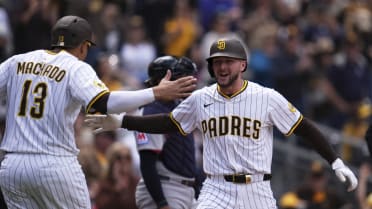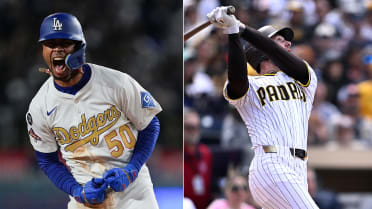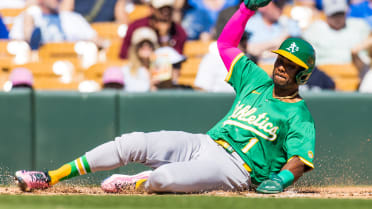It's not exactly a hot take to say that the Cubs are the best team in baseball, because they're 40 games over .500 and their magic number is down to five. They've got the lowest staff ERA in baseball. Chicago has scored the third-most runs per game, behind only Boston and Colorado. The Cubs have the most Defensive Runs Saved. They have baseball's highest walk rate, and they rank well on the bases, too. They're the most complete team we've seen in years.
So as we wait to see if the Cubs can back up all that hype in the playoffs, let's take a moment to point out that in one important area, they're not just "pretty good," they're potentially "historically good" -- at least so far as run prevention goes.
After beating the Astros, 9-5, on Sunday night, the Cubs have a 3.09 team ERA, the best in baseball. That's nearly half a run better than the second-place Nationals, who sit at 3.43, but perhaps on its own, that 3.09 number doesn't sound all that impressive; after all, it's just the fourth-best mark of the 21st century. The 2011 Phillies of Cole Hamels, Cliff Lee and Roy Halladay, for example, had a 3.02 mark.
But because of the way the run environment fluctuates from year to year, looking at raw ERA is less useful than looking at the difference above or below the league average. In the same way that hitting 40 homers would have been far more impressive in 1968's "Year of the Pitcher" (when only one hitter did so, Frank Howard) than in the hitter-friendly 2000 season (when 16 hitters hit 40), a team's ERA is only important when compared to what everyone else did that season. When those '11 Phillies had a 3.02 ERA, the National League had a 3.94 ERA overall. So far this year, with offense up across baseball, that NL number is 4.16.
So rather than just look at ERA, let's look at an advanced stat called "ERA-," which is a lot less scary than it sounds. It's merely "percentage points better than the league average," and we'll keep it simple by showing exactly that. Those 2011 Phillies, once park factors were accounted for, had an ERA 21 percentage points better than the NL average. This year's Cubs, despite having a slightly higher ERA than those Phils, are 25 percentage points better than the league average. That's how this works.
If we do that over the past 100 seasons of baseball, which comprises 2,180 team seasons, we can come up with a leaderboard. Right now, the Cubs are tied for the fourth-best run prevention season of the past century -- and entering Sunday's game, they were tied for best, before late homers by Yulieski Gurriel and Evan Gattis pushed them back down to second.
1917-2016, best team ERA compared to league ERA
26 percentage points above league -- 1926 A's/1939 Yankees/1944 Cardinals
25 percentage points above league -- 2016 Cubs/1993 Braves/three others
Now, for a team that has Jake Arrieta, Kyle Hendricks and Jon Lester in the rotation, and Aroldis Chapman, Héctor Rondón and rookie sensationCarl Edwards Jr. in the bullpen, maybe it's not surprising that they're doing so well at preventing runs. This is a roster full of pitching talent, particularly when Pedro Strop gets healthy to reinforce a rebuilt bullpen.
But here's the thing, and this is what's going to make life so difficult for NL Cy Young Award voters weighing how much credit to give to a pitcher like Hendricks: So, so much of this is about the Cubs' defense.
Gif: Kris Bryant strong throw
Consider this: Last year, the Cubs had a 3.36 ERA, the third best in baseball, and a 3.30 FIP, the best in baseball. ("FIP" is Fielding Independent Pitching, an ERA-like measure that looks at what a pitcher can control, like walks, strikeouts and home runs, and ignores the other factors like defense or batted-ball luck that might affect his run prevention.) Those numbers are nearly identical, and show that the Cubs' pitchers were rightfully one of the game's best staffs.
This year, as we know, the Cubs have the best ERA, at 3.09, but that FIP has jumped all the way up to 3.80, as Cubs pitchers have walked more and allowed more home runs. (Most teams in baseball have allowed more home runs this year, of course.) That difference of .71 is among the 10 largest ERA and FIP differences of the past 100 seasons. What that means is that the Cubs' pitchers haven't necessarily been better this year, but the earned runs allowed have dropped nonetheless.
Nowhere is that more apparent than with Hendricks, who has turned himself into a legitimate NL Cy Young Award candidate, despite this amazing fact: His FIP marks in each of the past two years are 3.36, but his ERA has dropped from 3.95 to 2.07. Hendricks is striking out slightly fewer than last year; he's walking slightly more. The difference is that the balls he allows in play simply aren't turning into hits, because the Cubs' defense has been spectacular -- their .253 Batting Average on Balls in Play is the lowest by any full-season team since the 1975 Dodgers, who had a .245 average with the famous Garvey-Lopes-Russell-Cey infield.
Remember, other than adding John Lackey, the Cubs' rotation hasn't changed all that much since last year, but the defense has. In 2015, the primary starting shortstop was Starlin Castro, with Addison Russell playing second before they swapped in August. Right field was manned mostly by Jorge Soler, who was rated as a below-average defender, and left field consisted of a combination of Chris Coghlan, Kyle Schwarber and Chris Denorfia, none of whom stood out. Javier Báez spent most of the year in the Minor Leagues.
This year, that's much different. Newcomer Jason Heyward's hitting woes haven't affected his elite defense in right. Fowler began to play deeper to prevent more extra-base hits. A full year of Russell has led to the most DRS of any shortstop, while Baez has dropped jaws with athletic plays at multiple positions. The only reason Anthony Rizzo and Kris Bryant don't get more attention for their fielding is because so much of it is focused on their slugging.
Gif: Jason Heyward's diving catch
There's about a million ways to explain how the Cubs' defense has been such a big factor here, but let's focus on simply one that shows such big improvement in the outfield. Let's look at all batted balls that weren't grounders or home runs that went between 200 and 400 feet, which are a rough sample of the kind of balls an outfield "could" get to. Last year, the Majors hit .400 on those kind of batted balls; this year, they're hitting .408, which shows stable performance.
Last year, the Cubs were among the worst at preventing hits on those types of balls -- their .419 was fourth from the bottom. (The top four teams all had elite center fielders: Kevin Kiermaier, Mike Trout, Lorenzo Cain and Juan Lagares, with the Rays letting just a .350 average.) This year, the Cubs are the best at preventing hits on those balls, at just a .364 average. They've improved by 55 points on the type of ball that represents more than a third of all batted balls, easily the best step forward of any team, and that's just one number that doesn't even really account for the air-tight infield.
Of course, the quality of the Cubs' pitching matters, because pitchers like Hendricks specialize in preventing high-damage batted balls, and relief imports Chapman and Edwards just don't let hitters make contact in the first place. This might be the best run-prevention team any of us will ever see, compared to the league average. It's not just the arms, though. It's those wonderful, fantastic gloves.
Mike Petriello is an analyst for MLB.com and the host of the Statcast podcast. He has previously written for ESPN Insider and FanGraphs.



